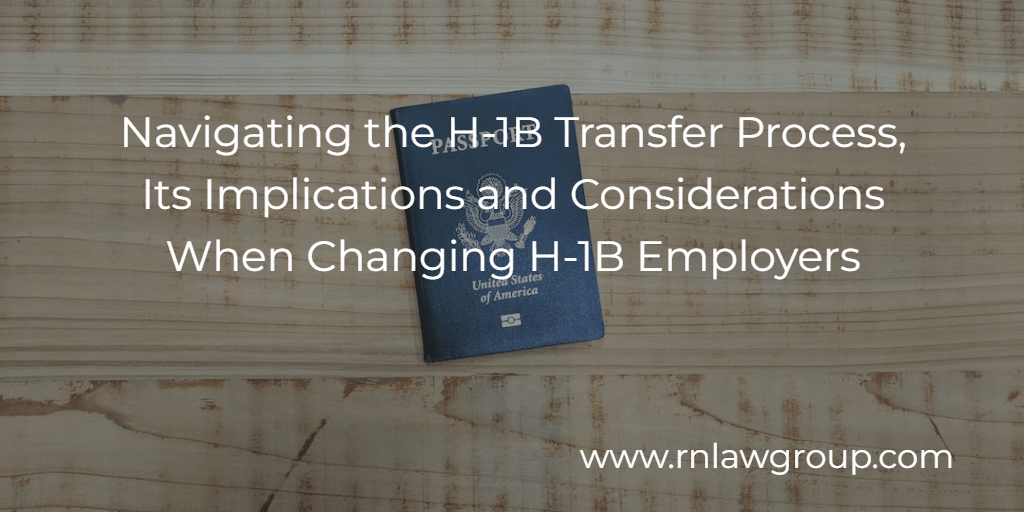
Navigating the H-1B Transfer Process, Its Implications and Considerations When Changing H-1B Employers
The H-1B nonimmigrant visa is a valuable pathway for skilled foreign workers seeking employment opportunities in the United States. However, the dynamics of the job market often lead H-1B holders to consider changing employers. The process of changing employers under the H-1B visa category involves several considerations, requirements, and different implications for both the visa holder and their dependents. In order to understand the process of changing employers, it is important to understand how this benefit is possible through The American Competitiveness of the Twenty-First Century Act (AC21) which allows for foreign workers to change jobs throughout their nonimmigrant status validity period. H-1B portability is a valuable provision that allows eligible H-1B nonimmigrants to change employers and continue their employment in the U.S. without disruptions. It promotes flexibility and mobility for skilled professionals, fostering a dynamic and competitive labor market.
Eligibility Criteria for H-1B Portability:
1. Valid H-1B Status: To be eligible for portability, the H-1B nonimmigrant must be currently employed in the U.S. under valid H-1B status.
2. New Employer’s H-1B Petition: The new employer must file a new H-1B petition (Form I- 129) on behalf of the H-1B nonimmigrant. This petition must be submitted before the expiration of the individual's current period of stay.
3. Occupational Qualification: The new job must be a specialty occupation, which generally requires a bachelor's degree or higher in a specific field related to the position. The employer must demonstrate that the position meets the criteria for an H-1B specialty occupation.
4. Timely Filing: The new H-1B petition must be filed before the expiration of the individual authorized period of stay, i.e., before the current Form I-94, Arrival/Departure Record, expires. If the H-1B holder is currently in a period of authorized stay while the petition is
pending, they can legally remain and work in the U.S. 5. Nonimmigrant Employee’s Admission into the U.S.: If the individual is outside the U.S., they must have been lawfully admitted into the country to qualify for H-1B portability. In other words, the person must have entered the U.S. with a valid visa and been inspected and admitted by a Customs and Border Protection (CBP) officer.
Implications and Benefits of H-1B Portability:
1. Immediate Employment: Once the new H-1B petition is filed under the portability provision, the H-1B nonimmigrant can start working for the new employer immediately, even before USCIS approves the petition. This allows for a seamless transition between jobs, minimizing employment gaps.
2. Flexibility and Career Mobility: H-1B portability provides flexibility for skilled foreign workers to explore new job opportunities, change employers, and pursue career growth within the United States job market. Even when the approval of the transfer petition is granted, the H-1B worker can still choose to stay with their current employer even if the transfer petition with the new employer was approved.
3. Increased Competitiveness: This provision enhances the competitiveness of H-1B workers in the job market, making it easier for them to attract job offers from various employers.
Considerations for Changing Employers:
When contemplating changing employers under the H-1B visa, individuals must assess various factors. One of the primary considerations is evaluating the new job opportunity in comparison to the current position as well as the qualification of the employer. For example, Is the company a cap-subject or cap-exempt employer? Are they are start-up company with not many other H-1B employees? Factors such as job role, compensation, company reputation, and career advancement prospects should be thoroughly examined. Particularly, with the type of role, the H-1B worker must ensure that the offered position is one that would qualify as a specialty occupation—requiring at least a bachelor’s degree in a related field of study to the position. With the current market in various industries, the only factor some employees have the luxury to consider is whether a job is available, especially if their employment has been terminated. Speaking of terminations, filing a transfer petition to change employers is an option to take with the 60-day grace period. The transfer petition will need to be filed within the 60-day grace period window and the H-1B worker can start employment with the new employer upon receipt of the petition by USCIS. It is important, to at all times, be sure that the I-94 is valid at the time filing any H-1B petition to USCIS.
Requirements for Changing Employers:
Firstly, the new employer must file a new H-1B petition on behalf of the employee. This involves submitting Form I-129, along with relevant supporting documents, such as visa, education and maintenance of status proof to the United States Citizenship and Immigration Services (USCIS). The new employer must prove the legitimacy of the job offer, the candidate’s qualifications, and adherence to prevailing wage requirements. Moreover, H-1B portability allows foreign workers to start working for the new employer upon the filing of the H-1B petition, even if the petition is still pending with USCIS. This flexibility facilitates a smooth transition between jobs and minimizes gaps in employment.
When the Change Takes Effect:
The H-1B visa holder can begin working for the new employer as soon as the H-1B petition is filed under the portability provisions. Unlike the initial H-1B visa application process, changing employers does not have specific annual quotas or lottery systems, making it more accessible for qualified candidates. The H-1B holder may start working for the new employer upon confirmation that USCIS received their filed transfer petition. In some instances, when contracting with third-party clients, the client might still require that an approval notice be received before the H-1B holder may begin their new role with the new employer.
Implications for the H-1B Nonimmigrant and Their Dependents:
For the H-1B nonimmigrant, the process provides an opportunity for career growth and mobility within the U.S. job market. It enables them to explore better job prospects and work for employers that align with their professional goals.
It is also important to consider potential implications for dependents, such as spouses and children on H-4 visas, when changing employers. The H4 visa status is wholly dependent on the maintenance of status of the H-1B holder. The H4 dependent may lawfully remain in the United States, enroll in educational programs and obtain other benefits for the full duration that the H-1B holder keeps valid H-1B status. Therefore, even if the H-1B holder changes employers, it may not be necessary to file an extension of the H4 or H4 EAD (where the H-1B has a valid I-140) if the H4 dependent’s I-94 is still valid for a long period. It is always an option to include the filing of an H4 dependent’s application concurrently with the filing of the transfer petition. Moreover, if the transfer petition is filed in premium processing, that processing time also applies to the concurrently filed H4 and applicable H4 EAD applications for an expedited processing time on all petitions.
Legal Considerations and Challenges:
Navigating the H-1B visa process can be legally complex. Employers must adhere to the regulations set forth by USCIS, ensuring that the new job offer complies with wage requirements and occupational classifications. Any missteps or discrepancies in the application process can lead to delays, requests for additional evidence, or denials. Additionally, the current political climate and policy changes in the U.S. immigration system can pose challenges. Changes in legislation or executive orders may impact the H-1B visa program, affecting the ability of nonimmigrants to change employers or creating additional requirements.
Conclusion:
Changing employers under the H-1B nonimmigrant visa category offers foreign workers the prospect of advancing their careers in the United States. However, this process demands careful consideration of job opportunities, understanding the requirements, and recognizing the implications for both the visa holder and their dependents. By staying informed, seeking legal counsel when necessary, and understanding the intricacies of the immigration system, H-1B visa holders can navigate the process successfully, ensuring a smooth transition to new and promising employment opportunities in the U.S.
Reddy & Neumann has been serving the business community for over 20 years and is Houston’s largest immigration law firm focused solely on U.S. Employment-based immigration. We work with both employers and their employees, helping them navigate the immigration process quickly and cost-effectively.
By : Jeanetly Garcia
Jeanetly Garcia advises employers and individuals through all phases of the non-immigrant visa process. As an attorney in the H-1B Department at Reddy Neumann Brown PC she is experienced in filing nonimmigrant petitions and applications for immigrant benefits, as well as, responding to USCIS issued requests for evidence concerning an array of legal issues.

